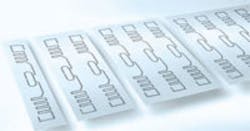Etching Alternative Emerges For RFID Antennas
Traditionally, RF-identification (RFID) antennas have been produced by etching conductive layers on substrates. Yet this approach is limited in resolution and accuracy. Now, Walki Group (www.walki.com) is striving to simplify the RFID-antenna manufacturing process while making use of its expertise in lamination. The firm's idea is to make a special laminate of aluminum on paper substrate. The aluminum foil is then cut in patterns using a laser. This approach can have far-ranging effects, as it is applicable to RFID antennas, printed-circuit boards (PCBs), and more.
The approach is dubbed Walki-4E, with the four Es in the name standing for efficient, exact, economical, and ecological. Compared with etching, the technology promises to eliminate a step from the tag-production or converter process. The firm's patented approach presents a new way of producing flexible circuit boards both efficiently and sustainably. Because this production process does not involve any liquid chemicals, it results in process residue that is easily recyclable.
The technique uses paper as the substrate, allowing RFID manufacturers to omit the insertion of the PET inlay into paper (Fig. 1). Among the approach's other benefits are that it allows for computer-to-antenna production and the accurate laser cutting of circuit-board patterns. The precise laser cutting of the patterns allows for smaller chips, greater repeatability in the production process, and higher antenna accuracy.
The technology can be used for the production of flexible circuit boards ranging from RFID antennas to boards for radiators and flexible displays. The digitalization of the process brings efficiency while allowing for variations in the patterns (Fig. 2). The first product to be launched using Walki-4E technology is Walki-Pantenna, an ultra-high-frequency (UHF) RFID antenna. It will be ready for mass production in 2012.
